|
BILLIARD PLAYER SONG
"Forgetting to give back/Isn't it a pity?"
It turned out, when your reporter got home and dug out his well-thumbed copy of "Notes From A Small Island", that Bill Bryson had not only written about Lulworth Cove, but had actually also visited the place that the feature you're reading now is about. Yet while the former fact had stuck in your correspondent's mind over the many years since first reading the book, the latter hadn't, despite Bryson having given it a much more favourable write-up. Funny old thing, the human memory.
But anyway. The end point of World Of Stuart's Summer Adventure 2006 marked a reprise of the theme of this reporter's first-ever travel piece. The Wiltshire "ghost village" of Imber, y'see, isn't the only place in Britain that was stolen from its inhabitants during World War 2 by the army and never returned to them. Dorset too has a ghost village, but unlike the bleak and forbidding Imber, with its grudgingly-occasional access and fake shell buildings defaced with resentful graffiti scrawled by the descendants of its dispossessed inhabitants, this one is a bucolic, idyllic and welcoming place. In fact, it may be the single most perfect pocket of beauty this reporter's ever found in his 15 years in England. It's called Tyneham.
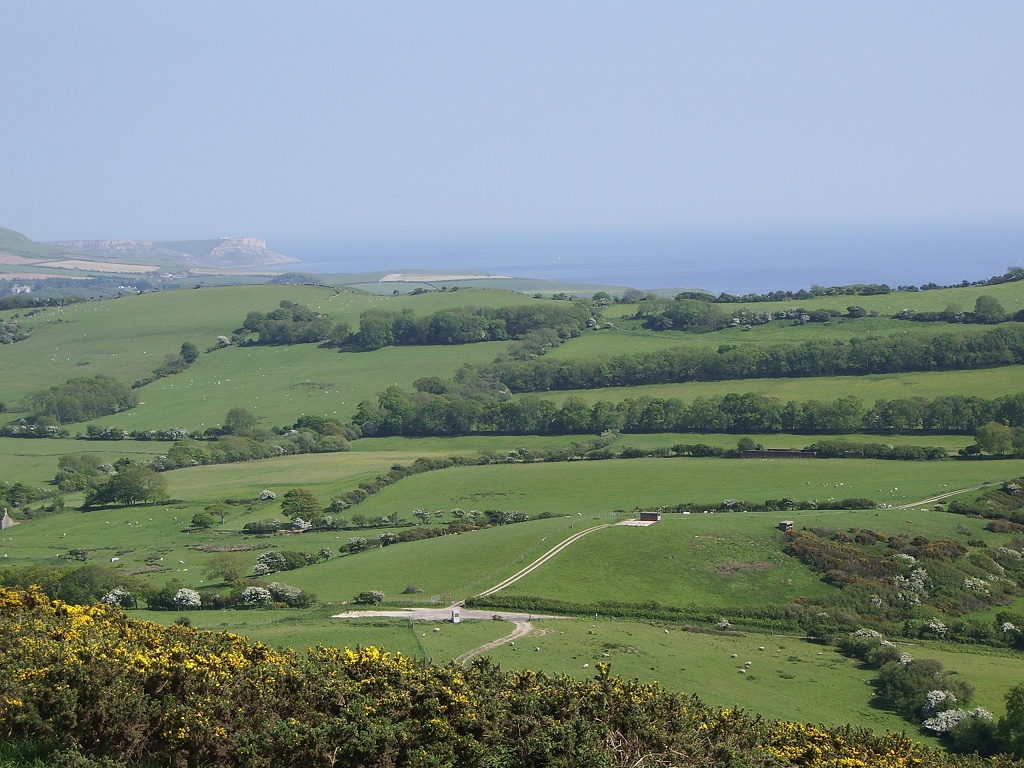
Not visible in shot: invading Nazi armies.
In 1943 (the same year Imber was requisitioned), the 250-odd inhabitants of the Tyneham valley were given one month to vacate their homes. Just like the people of Imber, they were compensated only to the value of the vegetables in their gardens (most of them were tenants), and told they'd be allowed back when the war was over. And just like the people of Imber, they never were. For many years Tyneham looked like suffering the same fate as its Wiltshire cousin, and it slowly crumbled through neglect as the army played war games in the surrounding countryside. In the 1970s, though, Tyneham and Imber's paths diverged.
After various campaigns and government committee reports, in 1975 a fairly liberal amount of public access was restored to the village and to the coastal walking routes nearby on the Lulworth Range. (Lulworth Cove to Tyneham and back is a pretty manageable six-mile stroll on a nice day.) The village church and school were both restored as museums, with lots of archive materials from the pre-war days. (Particularly interesting is the schedule and inventory of one cottage and its contents, recording its condition in estate-agent detail shortly after the army took control. The faded, tattered original document is preserved under glass for viewing in the church, and can be examined in this extra-large pic.) You can now visit Tyneham on most weekends of the year, as well as certain special times. And you should.
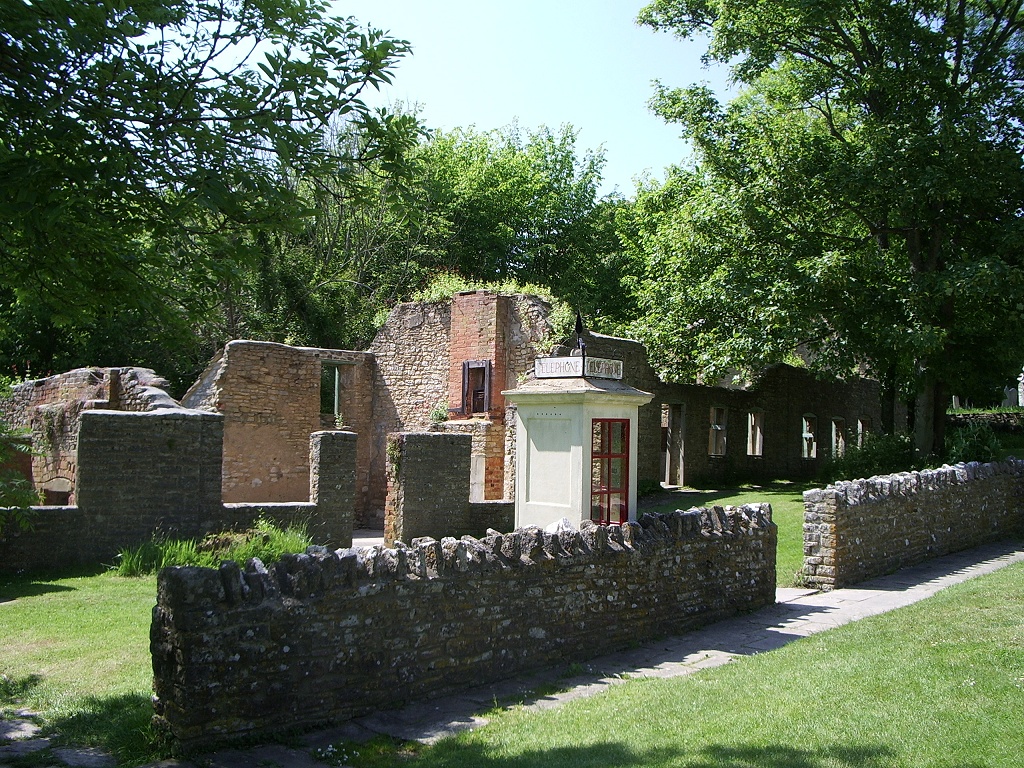
The first part of Tyneham you'll encounter, with perfectly-preserved phone box.
Compared to Imber, the village is quite easy to find, being helpfully signposted from the main Lulworth-to-Wareham road. (If you're using public transport there's a British Rail station at Wool, about four miles away on the Dorchester-Poole line, from which point you should be able to figure something out for yourself.) You approach along a long and winding country lane, which seems to double back on itself several times in the course of a few miles, greatly extending the distance and necessitating a fair deal of slowing to a crawl should you meet anyone coming the other way. You have to climb a hill before descending into the valley, which provides the picturesque vantage point from which the first image on this page was taken. (As well as one down into the adjacent valley, which is rather more functional.)
On reaching the village, you spot the first of Tyneham's new user-friendly features, in the form of a sizeable car park capable of holding maybe 100 vehicles. Your reporter joined perhaps 20 other cars there, and dropped a pound coin (the suggested voluntary contribution to the village's upkeep for a whole day's parking) into the unmanned honour box. Most of their occupants must have been off on walks, because although the village is only a couple of hundred yards square, I bumped into fewer than a dozen other people during the two hours I wandered around, and five of those were from a single family. (Mind you, if I'd known beforehand how much I was going to be ripped off for 45 minutes' parking in Lulworth Cove, I'd have left the car in Tyneham and walked there instead too...)

That's the church in the distance, seen from the outhouse of the old Gould place.
In a further marked contrast to the sad fate of Imber, when Tyneham's open to public access it's fully open. You can go anywhere you like, including right inside the buildings (most of which are roofless shells, so there's no danger of anything collapsing on your head), and look as closely as you like at what remains. When your reporter arrived, a small group of young children were running around noisily (but harmlessly) playing hide-and-seek in the row of cottages nearest the car park, and there were no distrustful wardens or rope barriers or CCTV cameras or warning signs to discourage them. It feels, if you'll forgive the momentary flight of fancy, that the village is just happy to be hosting some kind of life again.
(Presumably, the site's remote location, and distance from any big towns, is sufficient to discourage the sort of cretinous pondscum who might otherwise take destructive advantage of this situation. Either that or the close proximity of a lot of armed guys in tanks.)
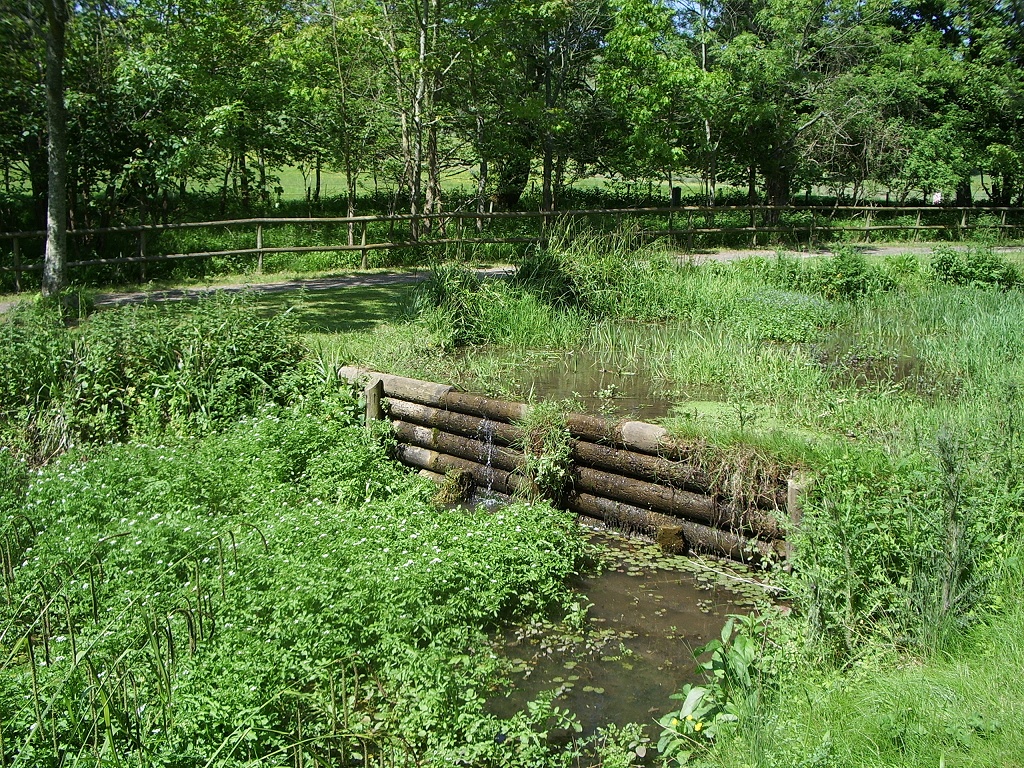
Honestly, the place is just stupidly beautiful.
And even aside from the restored church and school, there's a lot of fascinating stuff to see amid the ruins. Quite a few original features survive in many of the houses, including fireplaces and weird metal constructions that your architecturally-uneducated correspondent would assume to be some kind of upper-floor support or ceiling strut. One cottage has a curious, very deep copper basin of some sort, which I'd guess was for washing clothes in. What you can't help noticing is how small most of the houses are, which is slightly odd given that space was hardly at a premium, but then again the village does date back to the 13th Century, when you couldn't just turn the thermostat up to heat large rooms.
Still, for all the interesting things to be found in the various cottages, the majority of the noteworthy content in Tyneham is held in the church and school. Unfortunately the school was closed for some repair work to the ceiling when your correspondent was there (as can be seen in this shot taken through a window), so it's for the church that we now depart.
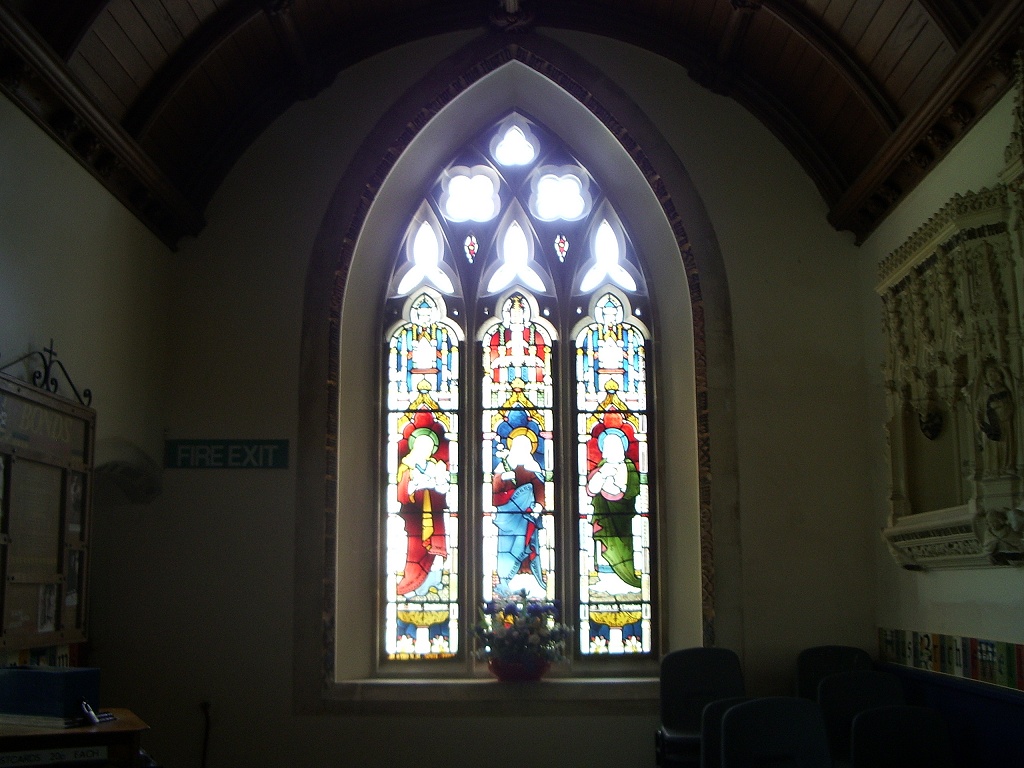
One of the church's restored stained-glass windows.
(Exterior lighting courtesy of the Sun.)
Tyneham's church now serves two separate purposes, neither of them its original one. Most obviously it's a museum, not only of itself but also the rest of the village. It's full of charts and displays, recording both the broad history and the minutiae of village life - there are documents, artefacts, timelines, old photographs and everything else you'd expect to find in a small town museum, and barely more interesting than any other town's. There are also activity leaflets, mini-guidebooks and postcards of the church's two fine stained-glass windows for sale, again via the touching "honour box" system.
The second function of the church, though, is to act as a sort of memorial shrine to the life that the inhabitants had so unfairly taken away. The names of the villagers now line the church's inside walls like a yellow ribbon, and also grace a restored bible in the quire (where the names are lovingly listed in beautiful script, with "parishioners" spelt wrongly). It's a restrained, polite but unmistakeable protest, a permanent public rebuke to the treacherous authorities who betrayed and robbed the villagers, and it's quietly moving.
(Sadly, your reporter can't say the same thing about himself. Every time I switched on my camera inside the church to take a picture, its startup beeps echoed deafeningly off the stone walls like someone was backing a bin lorry into the transept, and when I used the flash the whole place lit up like a Vegas strip joint. When I went upstairs and sat in the quire out of sight - so that the small group of nice elderly people who were viewing the various exhibits could finish doing so in peace before I took any more snapshots with my portable rave-party sound system - I managed to drop it on the wooden floor, causing a massive reverberating thud that almost gave one old lady below a heart attack. I was mortified.)
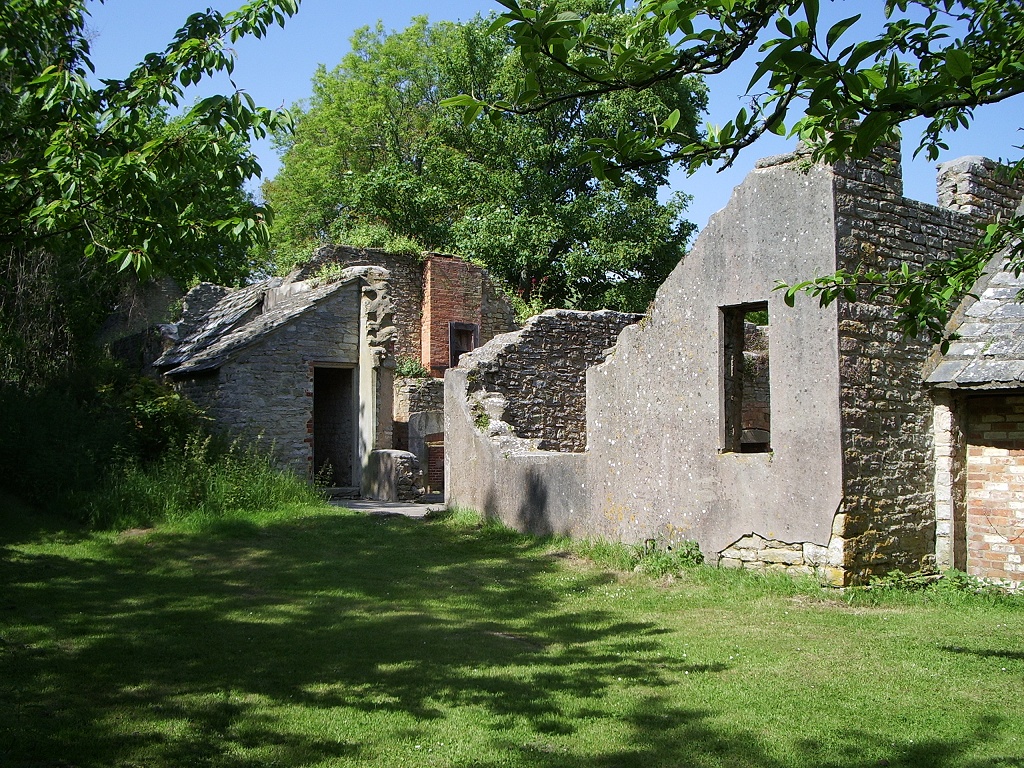
The building on the far left is an outside toilet. Retro!
Tyneham itself is almost infinitely tranquil (well, except when I'm there, clearly), but the thick-walled church is an epically still and silent place, in which you find yourself shushing your own heartbeat. Time seems to stop when you're inside it, and that's my excuse for discovering that 40 minutes had passed by the time I eventually emerged into the blinding sunshine and the soft, carefully-tended grass of the church's graveyard.
For all the interesting but dry information posted elsewhere, nothing brings home the sense of loss like a wander among the graves. It's only then, when you read the dates and realise just how long humans had been living here, that the full enormity of the legal theft of so many homes, lives and memories hits you. (Particularly sad are the headstones laid in the churchyard in memorial of people born in the early 20th Century, in the prime of life in 1943, and who only died a few years ago, never having been allowed to go back home.)
Who, living here with seven hundred years of history and heritage all around them, could ever have imagined the consequences for their own tiny village of Hitler sending his tanks across the Polish border in the late summer of 1939? Who in Tyneham could possibly have foreseen that while they lived just a few hundred yards from Britain's beleaguered south coast, the war would reach out to strike at them not from across the English Channel, but from behind them, from the heart of the government charged with their protection?

If you're going to spend eternity in the ground, it might as well be ground this nice.
Fortunately for your correspondent, such a maudlin frame of mind couldn't survive long in the scorching June sunshine, and the extraordinary pastoral beauty of the village quickly reasserted its captivating grip. It's difficult to overstate just how lush and green the valley is, almost unsullied by the presence of humans. Tyneham shelters amid groves and avenues of trees, dappling the light and providing cool shade everywhere to protect the wandering visitor from the burning rays. Little streams and ponds provide sparkling water, glinting and dancing in the sun. It's prettiness beyond cliché, beyond parody, beyond anything.
The other effect of all the vegetation is that you're constantly finding new pieces of the village just when you thought you'd seen it all. The old rectory, next in line for restoration, with its barns and outbuildings. The Grant and Willman homes, out at the far south-west corner of the settlement, or the Everett cottage nestled peacefully by trees and a stream.
But even when you've eventually found everything, you keep going back - finding new routes between different bits, and approaching from different angles to spot features you'd overlooked before. Your reporter spent over two hours lost and entranced in Tyneham, though it's barely 200 yards square, and has rarely spent hours more blissful. Were it not for the compelling desire to share it with you, beloved viewers of WoS, I'd probably still be there now. As I left, I put some more money into the car-park honour box, and pondered how the hell I was ever going to find my way back onto the A303. But I didn't really care.

Peace out to WoS viewer Marcus Durham for the alert to the existence of Tyneham.
|

